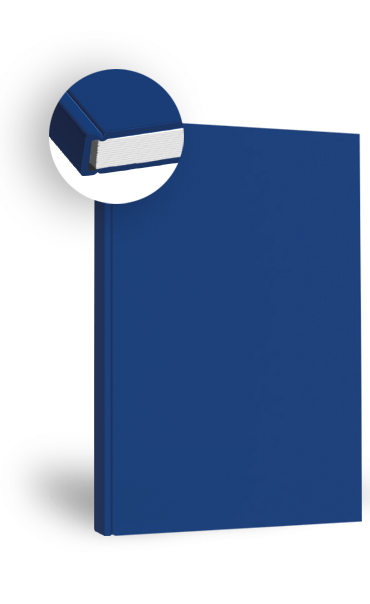Types Of Bindings
Overview of types of bindings
✓ Types of hardcover bindings
✓ Types of softcover bindings
✓ Special types of bindings
From
$7.90
Express delivery:
All types of bindings at a glance
Hardcover bindings
Case binding
| Case binding is a method where the pages are securely attached to a rigid, pre-made cover. It is one of the most durable and high-quality binding methods, often used for hardcover bindings. | ||
| Type of binding | Sewn or glued and then attached to a hard case made of cardboard, which is covered with fabric, paper, or leather. | |
Pros
|
Cons
|
|
Use
|
Similar bindings |
|
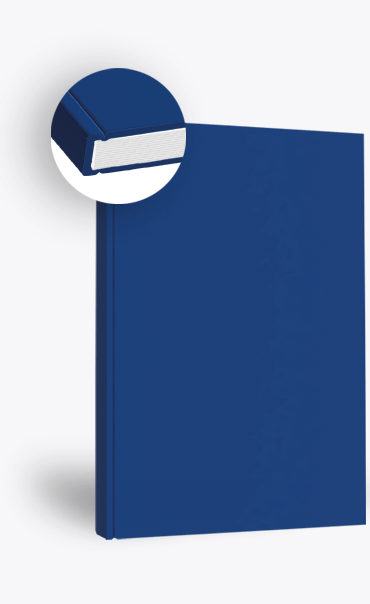
Hardback binding
| Hardback binding involves enclosing the pages in a rigid, durable cover made of cardboard, often covered with cloth, leather, or paper. It provides a high-quality and professional appearance. | ||
| Type of binding | Sewn or glued and then attached to the hard cover. The spine can be straight or rounded, with reinforced edges. | |
Pros
|
Cons
|
|
Use
|
Similar bindings |
|
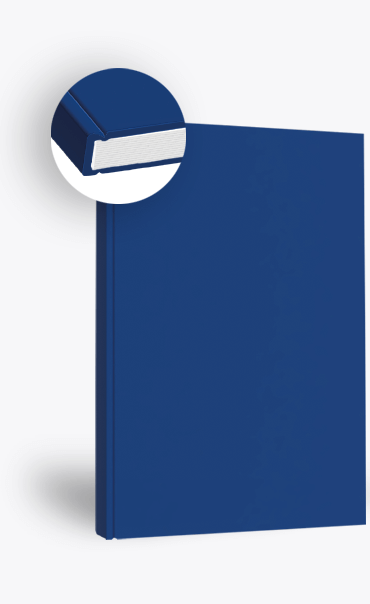
Hardbound binding
| Hardbound binding features a sturdy cover made of cardboard that is wrapped in materials like cloth, leather, or paper. It securely holds the pages, providing a durable and professional finish. | ||
| Type of binding | Sewn or glued and attached to the rigid hard cover. The spine can be straight or rounded, depending on the design. | |
Pros
|
Cons
|
|
Use
|
Similar bindings |
|
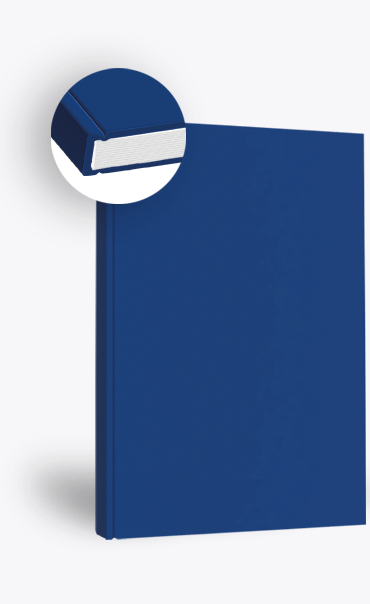
Hardcover
| Hardcover is a binding method where the book block is secured in a sturdy cover made from thick cardboard, often wrapped in cloth or leather. It provides a premium and durable finish for books. | ||
| Type of binding | Sewn or glued and then attached to the rigid cover. The spine may be flat or rounded, and decorative features can be added. | |
Pros
|
Cons
|
|
Use
|
Similar bindings |
|
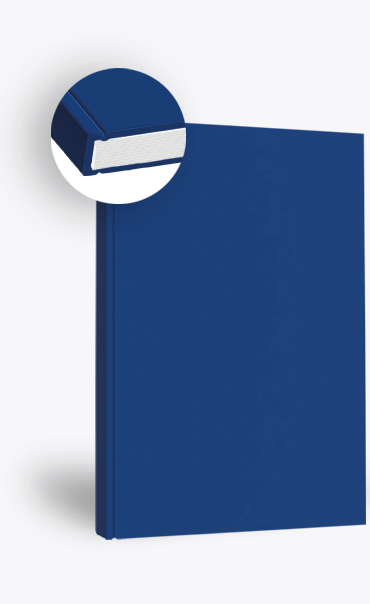
Leather book binding
| Leather book binding is a premium binding method where the cover is made of real or synthetic leather, offering an elegant appearance. It provides exceptional durability and timeless aesthetic appeal. | ||
| Type of binding | Sewn or glued and then attached to a rigid cover wrapped in leather. In our shop, we use vegan leather, which replicates the texture and quality. | |
Pros
|
Cons
|
|
Use
|
Similar bindings |
|
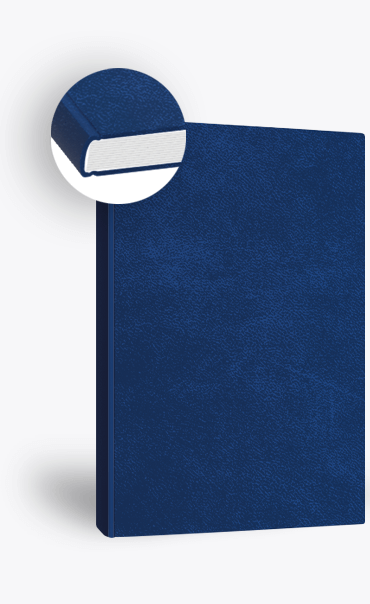
Library binding
| Library binding is a highly durable binding method designed for books that undergo frequent use, such as those in libraries or archives. It provides extra protection to the book block and ensures long-term usability. | ||
| Type of binding | Sewn with a reinforced spine and encased in a hard cover made from durable materials like buckram or reinforced cloth. | |
Pros
|
Cons
|
|
Use
|
Similar bindings
|
|
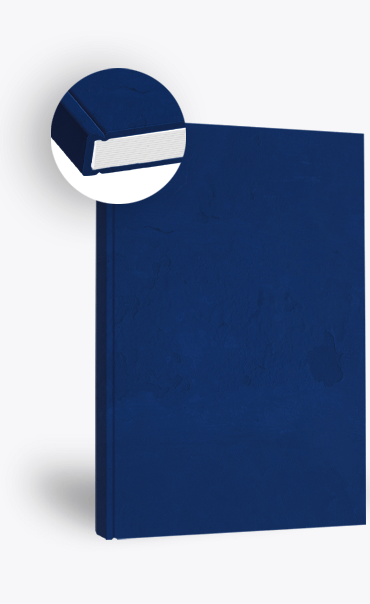
Flexibound binding
| Flexibound binding is a hybrid binding method that combines the flexibility of a softcover with the durability of a hardcover. The cover is made of a flexible yet sturdy material, offering a high-quality, professional appearance. | ||
| Type of binding | Sewn or glued and attached to a semi-rigid cover made from flexible materials, like reinforced card stock or thinner boards. | |
Pros
|
Cons
|
|
Use
|
Similar bindings
|
|
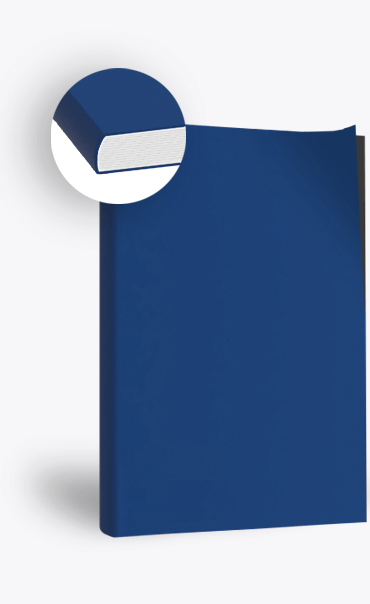
Bradel binding
| Bradel binding is a traditional bookbinding method where the cover (case) is constructed separately from the book block and then attached. It provides a refined, durable, and flexible finish. | ||
| Type of binding | Sewn or glued and attached to a spine liner for added flexibility. The case is built independently of the block using stiff boards. | |
Pros
|
Cons
|
|
Use
|
Similar bindings
|
|
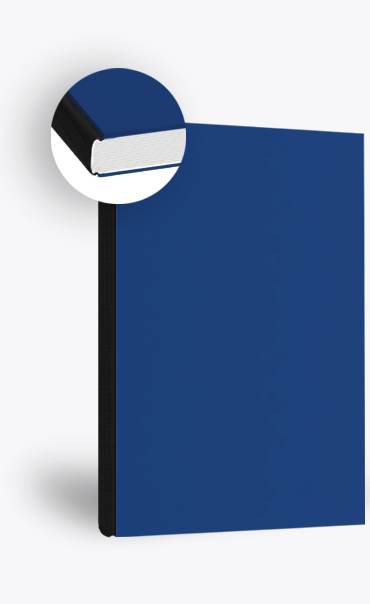
Dutch binding
| Dutch binding is a technique where the book’s spine remains uncovered, showcasing the stitching or glue used to hold the pages together. It combines a minimalist aesthetic with functionality. | ||
| Type of binding | Sewn, leaving the spine exposed without a cover. The front and back are attached to the book block but do not connect across the spine. | |
Pros
|
Cons
|
|
Use
|
Similar bindings
|
|
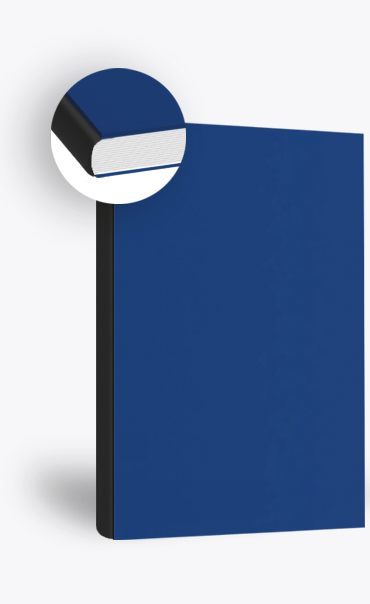
Secret Belgian binding
| Secret Belgian binding is a hand-sewn bookbinding technique where the book block is attached to a woven spine and cover structure. There is an intricate stitching pattern that adds a decorative element to the book. | ||
| Type of binding | Covers and spine are created separately and joined with thread using an interwoven sewing pattern. The book block is then sewn into this structure. | |
Pros
|
Cons
|
|
Use
|
Similar bindings
|
|
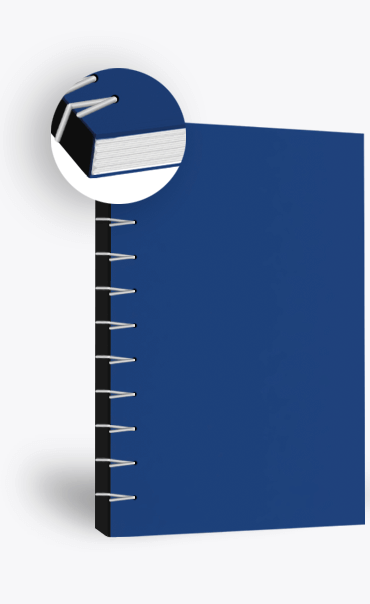
Leather binding
| Leather binding is a premium bookbinding technique where the book’s cover is made from real leather or high-quality synthetic alternatives. It is known for its luxurious appearance, durability, and timeless appeal. | ||
| Type of binding | Sewn or glued and attached to a rigid cover wrapped in (vegan) leather. It can include decorative features for added elegance. | |
Pros
|
Cons
|
|
Use
|
Similar bindings
|
|
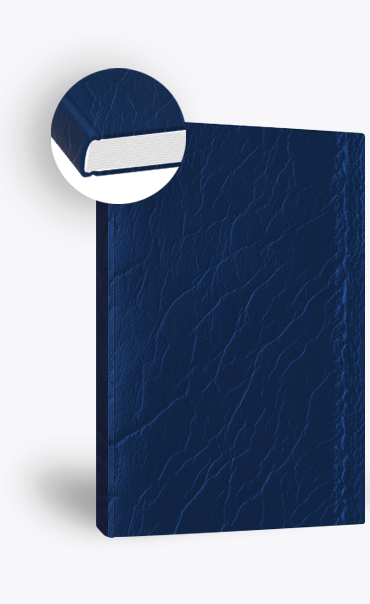
Faux leather book binding
| Faux leather book binding uses synthetic leather materials to replicate the look and feel of real leather. It offers a luxurious appearance while being more affordable, cruelty-free, and eco-friendly. | ||
| Type of binding | Sewn or glued and attached to a cover made of faux leather material. Decorative features can be added to enhance the appearance. | |
Pros
|
Cons
|
|
Use
|
Similar bindings
|
|
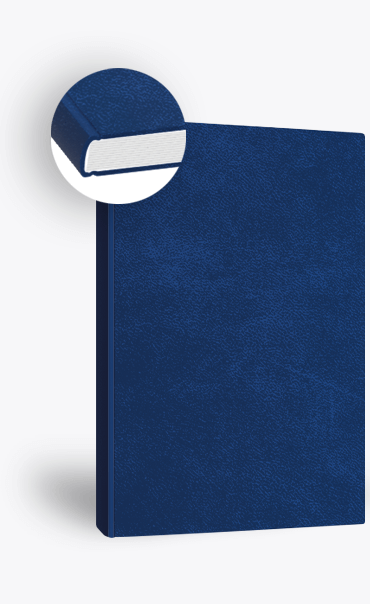
Quarter binding
| Quarter binding is a bookbinding style where a different material is used to cover the spine and part of the covers, while the remaining portion of the covers is made from a contrasting material like paper, cloth, or leather. | ||
| Type of binding | Sewn or glued and attached to a rigid or semi-rigid cover. The spine and corners use durable material, with the rest in lighter contrasting material. | |
Pros
|
Cons
|
|
Use
|
Similar bindings
|
|
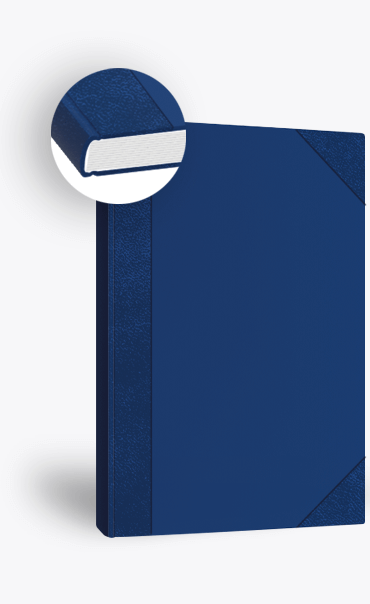
Half leather binding
| Half leather binding features a leather-covered spine and corners, while the remaining cover is made from a contrasting material like cloth, paper, or faux leather. It offers a balance of durability and aesthetic appeal. | ||
| Type of binding | Sewn or glued and attached to a rigid cover. Leather is used for the spine and corners, while the rest is made from lighter materials. | |
Pros
|
Cons
|
|
Use
|
Similar bindings
|
|
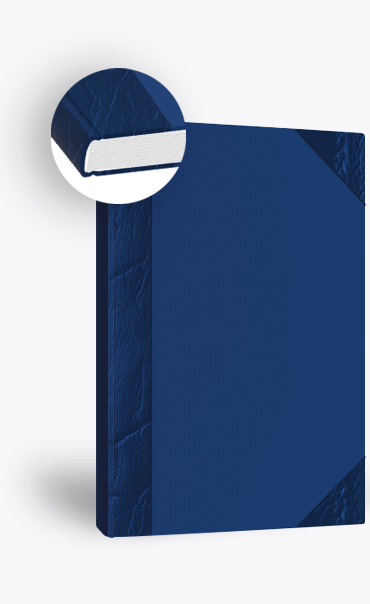
Quarter leather binding
| Quarter leather binding features a leather-covered spine, while the rest of the cover is made from a contrasting material like cloth or paper. This design creates a durable and cost-effective binding with a classic aesthetic. | ||
| Type of binding | Sewn or glued and attached to a rigid cover. Leather is used for the spine, while the rest of the cover uses a complementary material. | |
Pros
|
Cons
|
|
Use
|
Similar bindings
|
|

Morocco book binding
| Morocco book binding uses high-quality goatskin leather, known for its durability, flexibility, and smooth texture. This binding is associated with luxury and is commonly used for premium and collector’s editions. | ||
| Type of binding | Sewn or glued and attached to a rigid cover made from Morocco leather. The leather is often dyed in vibrant colors and may include decorative elements. | |
Pros
|
Cons
|
|
Use
|
Similar bindings
|
|
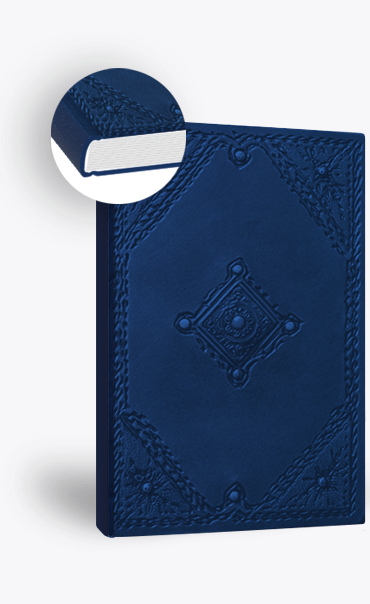
Calf binding
| Calf binding uses leather made from calfskin, valued for its smooth texture, fine grain, and luxurious appearance. This binding is associated with high-quality books and has been widely used for centuries in fine bookbinding. | ||
| Type of binding | Sewn or glued and encased in a cover made of calfskin leather. The leather can be left plain, polished for a glossy finish, or decorated. | |
Pros
|
Cons
|
|
Use
|
Similar bindings
|
|
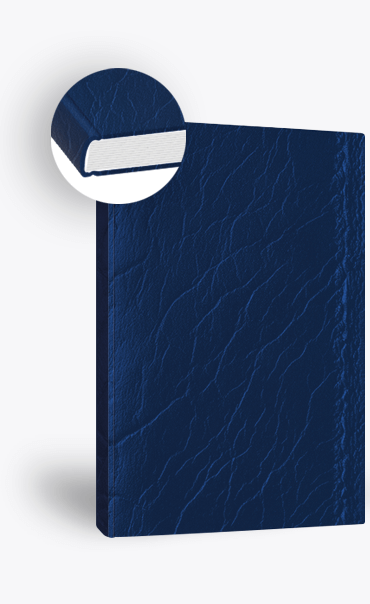
Softcover bindings
Thermal binding
| Thermal binding is a binding method that uses heat to melt adhesive along the spine of the book block, attaching the pages securely to a pre-made cover. It provides a sleek appearance, ideal for quick and easy binding. | ||
| Type of binding | Loose pages are placed in a cover with adhesive on the spine. The cover is then heated in a machine, melting the glue and securing the pages in place. | |
Pros
|
Cons
|
|
Use
|
Similar bindings |
|
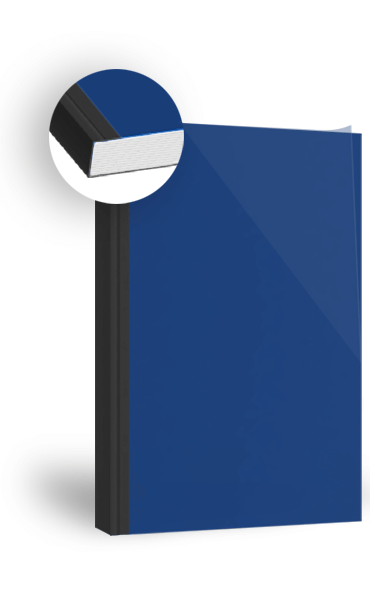
Paperback
| Paperback is a softcover binding made of a paper cover. The book block is glued into the flexible cover, which is made of thin but sturdy paper. In some cases, the paper cover is coated with a thin laminate for added protection. | ||
| Type of binding | Bound with a perfect binding technique (gluing the spine), and the cover is made from durable yet flexible, printable card stock. | |
Pros
|
Cons
|
|
Use
|
Similar bindings
|
|
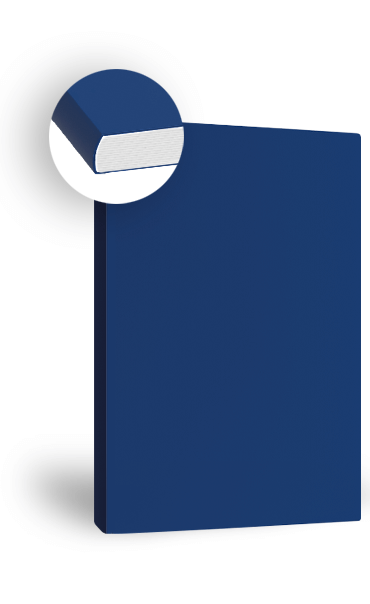
Mass market paperback
| A mass market paperback (MMP) is a smaller and less expensive version of a paperback. The book block is glued into a flexible and printable paper cover. Laminating the cover is rarely done with mass market paperbacks. | ||
| Type of binding | Bound by gluing the book block to the spine with a flexible and printable cover made from paper. | |
Pros
|
Cons
|
|
Use
|
Similar bindings |
|
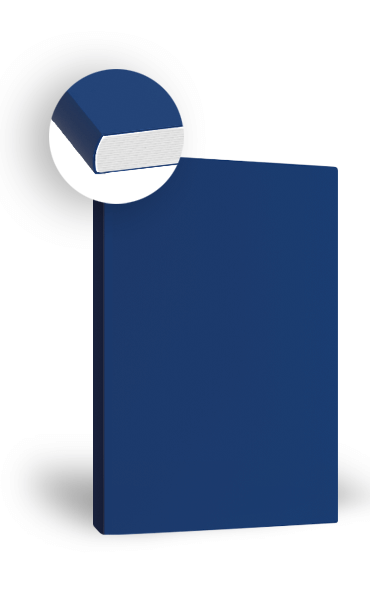
Perfect binding
| Perfect binding is a widely used binding method where the pages of a book are glued along the spine to a flexible cover. It creates a clean, professional look and is commonly used for softcover books. | ||
| Type of binding | Pages are trimmed to create a flat spine, and then glued together using a strong adhesive. The cover is wrapped around the glued spine. | |
Pros
|
Cons
|
|
Use
|
Similar bindings
|
|
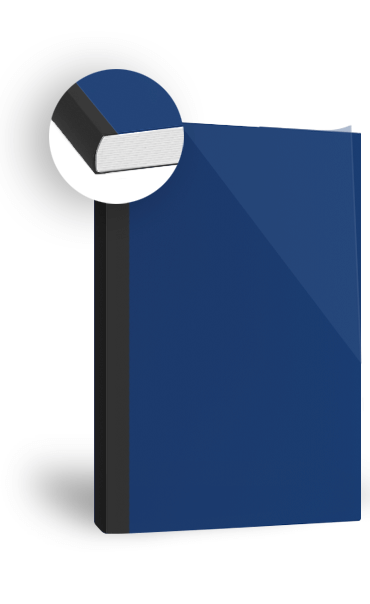
Tape binding
| Tape binding is a simple and affordable binding method where a strong adhesive tape is applied along the spine of loose pages to hold them together. It is quick to produce and ideal for short-term or low-budget projects. | ||
| Type of binding | Loose pages are aligned and secured with a strip of adhesive tape along the spine. No need for punching or sewing. | |
Pros
|
Cons
|
|
Use
|
Similar bindings |
|
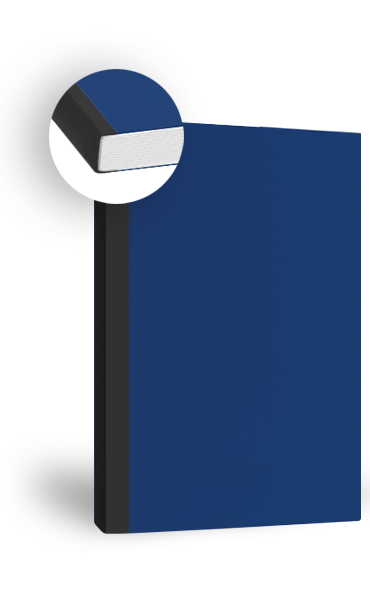
Side staple binding
| Side staple binding is a simple and affordable binding method where staples are inserted along the left edge (spine) of stacked pages. It is widely used for documents with limited page counts. | ||
| Type of binding | Pages are stacked and aligned, then stapled near the spine or edge. The staples run vertically along the side. | |
Pros
|
Cons
|
|
Use
|
Similar bindings
|
|
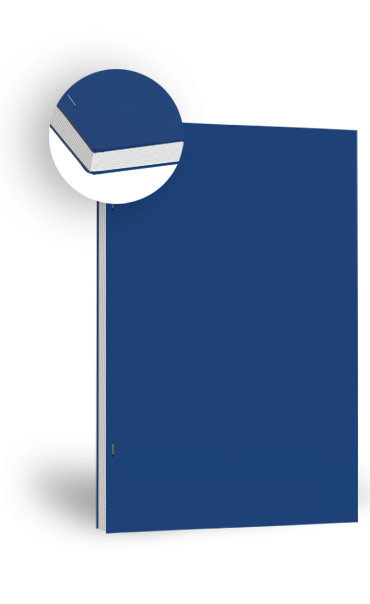
Saddle stitch binding
| Saddle stitch binding is a simple and affordable method where folded sheets are nested together and stapled along the center fold (spine). This creates a clean finish, and the simplicity allows the pages to lie flat when open. | ||
| Type of binding | Pages are folded and placed inside one another, then stapled through the fold using wire staples. This creates a clean and flexible spine. | |
Pros
|
Cons
|
|
Use
|
Similar bindings
|
|
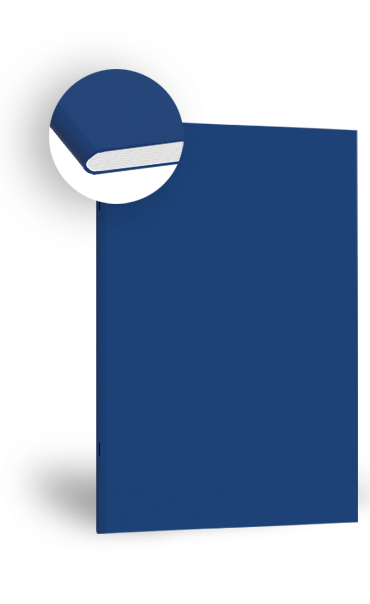
Staple binding
| Staple binding is a simple and cost-effective method where metal staples are used to bind pages together, either along the spine or along the edge. It is ideal for lightweight, low-page-count documents. | ||
| Type of binding | Pages are stacked, aligned, and stapled using either a center-folded technique or stapled along one edge. | |
Pros
|
Cons
|
|
Use
|
Similar bindings
|
|
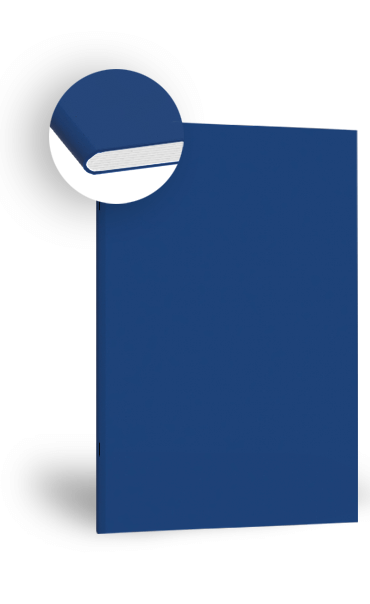
Singer sewn binding
| Singer sewn binding is a decorative and functional bookbinding method where a single thread is sewn along the spine, visible on the exterior. It combines durability with a minimalist aesthetic. | ||
| Type of binding | Pages are aligned and stitched together along the spine using a sewing machine or hand stitching. The thread is left exposed. | |
Pros
|
Cons
|
|
Use
|
Similar bindings
|
|
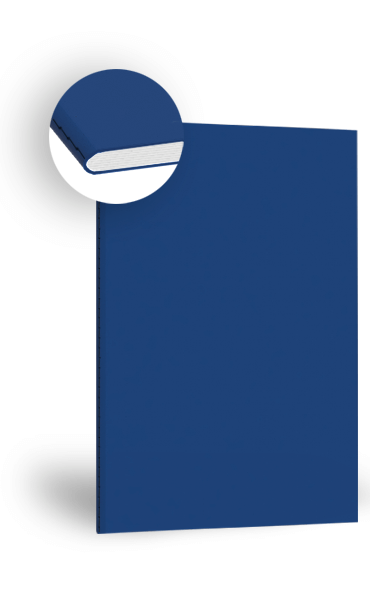
Section-sewn binding
| Section-sewn binding is a bookbinding method where individual folded sections (signatures) of pages are sewn together along the spine. It is commonly used for high-quality and long-lasting books. | ||
| Type of binding | Pages are grouped into signatures, folded, and sewn together with thread along the spine. The sewn sections are then glued and attached to a cover. | |
Pros
|
Cons
|
|
Use
|
Similar bindings
|
|
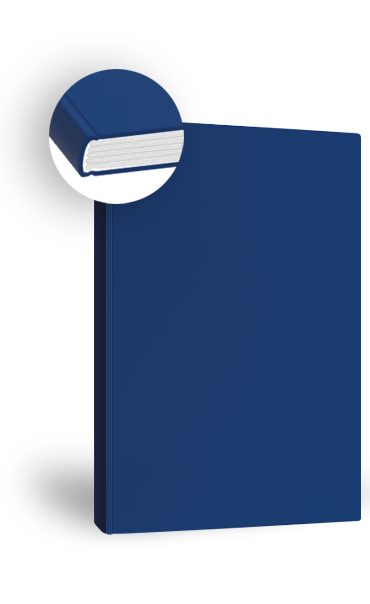
Pamphlet stitch binding
| Pamphlet stitch binding is a simple hand-sewn binding method used to bind single-signature booklets. It involves stitching pages together through the spine using thread. | ||
| Type of binding | Pages are folded together into a single signature and pierced along the spine. A needle and thread are used to sew the pages through the holes. | |
Pros
|
Cons
|
|
Use
|
Similar bindings
|
|
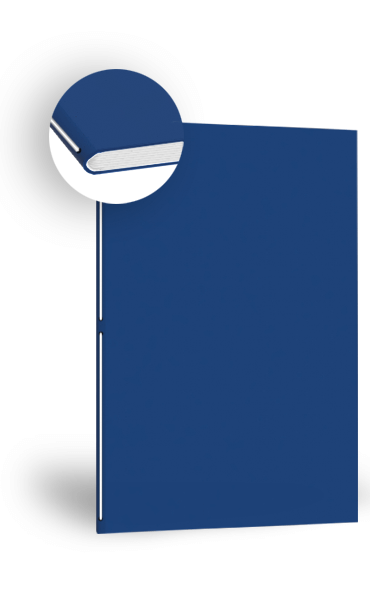
Side-stitch binding
| Side-stitch binding is a method where pages are stacked and sewn together along the side near the spine using a strong thread or wire. It is used for documents with thicker page counts that cannot be saddle-stitched. | ||
| Type of binding | Loose or pre-collated pages are aligned and stitched along the side near the spine using thread or a wire stitch. Covers are often added afterward. | |
Pros
|
Cons
|
|
Use
|
Similar bindings
|
|
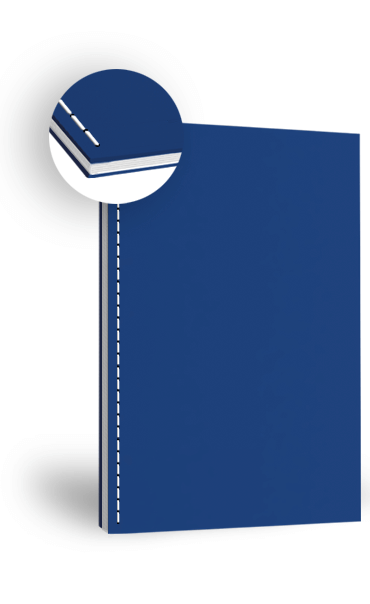
Burst binding
| Burst binding is similar to perfect binding, where the spine of the book block is perforated (burst) before glue is applied. The perforations allow adhesive to seep into the pages, creating a stronger binding. | ||
| Type of binding | Pages are perforated along the spine, and adhesive is applied. The glue seeps into the perforations, securing the pages to the spine. | |
Pros
|
Cons
|
|
Use
|
Similar bindings
|
|
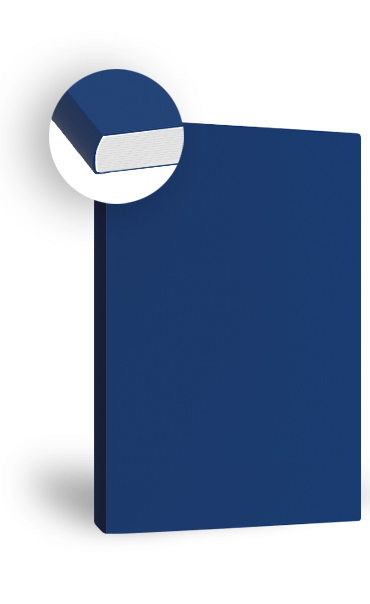
Softback
| Softback is a binding method where the book block is attached to a flexible cover made from paper or card stock. It is lightweight and commonly used for casual or widely distributed publications. | ||
| Type of binding | The book block is glued along the spine and attached to a soft laminated cover made of durable paper or card stock. | |
Pros
|
Cons
|
|
Use
|
Similar bindings
|
|
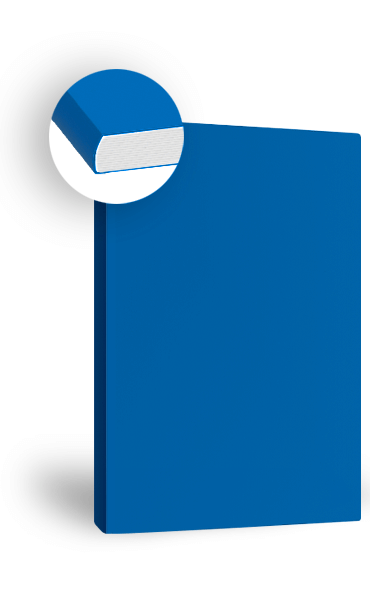
Notch binding
| Notch binding cuts small notches along the spine of the book block. These notches allow the glue to penetrate deeper into the pages, creating a stronger bond and improving the durability of the binding. | ||
| Type of binding | The spine of the book block is notched at regular intervals, and adhesive is applied to bind the pages. | |
Pros
|
Cons
|
|
Use
|
Similar bindings
|
|
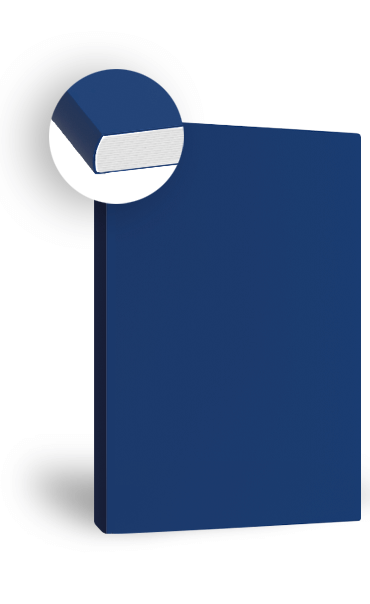
Paper case binding
| Paper case binding is a lightweight and cost-effective binding method where the book block is enclosed in a stiff paper cover. It provides a simpler alternative to hardcover while maintaining a professional appearance. | ||
| Type of binding | Sewn or glued and attached to a cover made from thick paper. The spine is reinforced, and the cover may include printed or decorative designs. | |
Pros
|
Cons
|
|
Use
|
Similar bindings
|
|
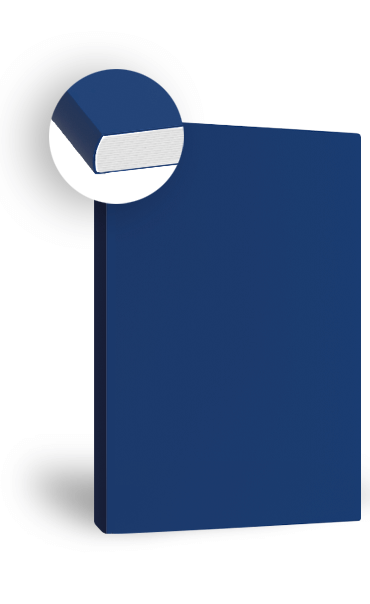
Spiral bindings
Comb binding
| Comb binding is a binding method where the book block is punched along the side and connected with a plastic or metal spiral. The spiral holds the pages securely yet flexibly. | ||
| Type of binding | Pages are punched with evenly spaced holes along the spine. A comb is threaded through these holes. | |
Pros
|
Cons
|
|
Use
|
Similar bindings
|
|
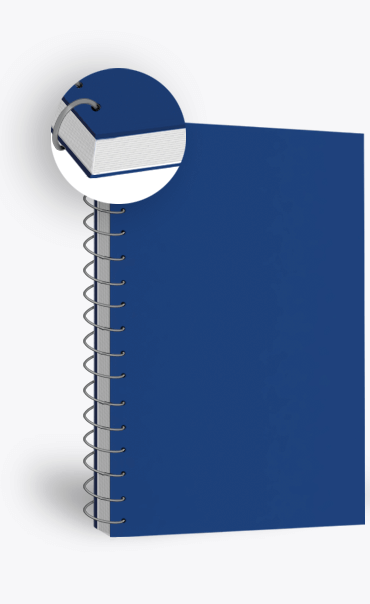
Coil binding
| Coil binding uses a plastic or metal coil threaded through evenly spaced holes punched along the edge of the pages to hold them securely together. It allows for flexible handling and 360-degree page rotation. | ||
| Type of binding | Pages are punched along the binding edge, and a continuous plastic or metal coil is twisted through the holes. This coil holds the pages securely. | |
Pros
|
Cons
|
|
Use
|
Similar bindings
|
|
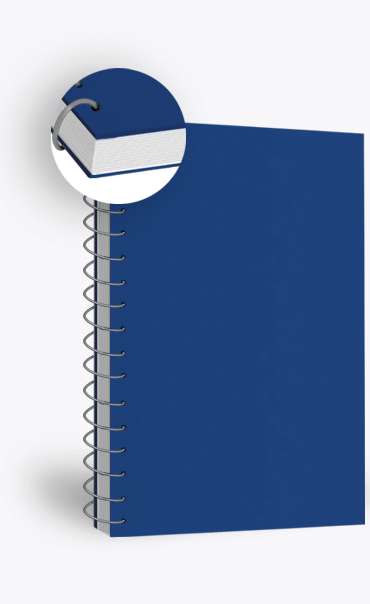
Spiral binding
| Spiral binding is a method where a continuous plastic or metal coil is threaded through holes punched along the edge of the pages, securely holding them together while allowing for full rotation and easy page handling. | ||
| Type of binding | Pages are punched with holes, and a spiral coil is inserted and twisted through these holes. The binding allows the pages to open fully flat. | |
Pros
|
Cons
|
|
Use
|
Similar bindings
|
|
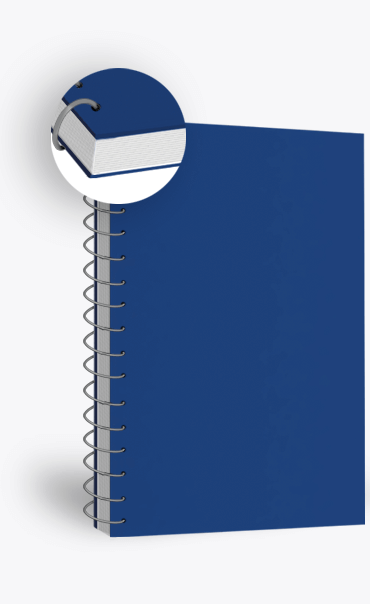
Wire binding
| Wire binding uses a double-loop metal wire threaded through holes punched along the edge of the pages. It provides a secure and professional finish while allowing the document to open flat or fold back 360 degrees. | ||
| Type of binding | Pages are punched with rectangular or square holes along the spine. A double-loop metal wire is inserted and then closed to secure the pages. | |
Pros
|
Cons
|
|
Use
|
Similar bindings |
|
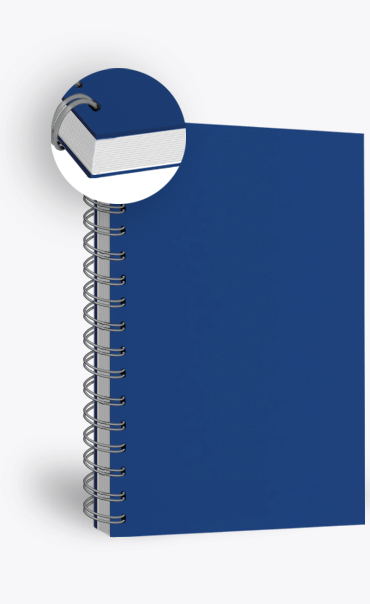
Wire-O binding
| Wire-O binding uses a series of double metal loops threaded through punched holes along the spine. It creates a secure, professional finish while allowing the pages to lay flat or fold back 360 degrees. | ||
| Type of binding | Pages are punched with holes along the edge. A double-loop wire is inserted and then squeezed closed to secure the pages. | |
Pros
|
Cons
|
|
Use
|
Similar bindings
|
|
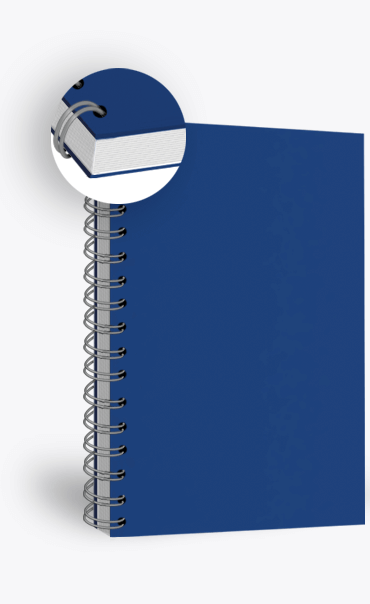
Ring binder
| Ring binders use a ring mechanism (typically 2, 3, or 4 rings) within a binder to hold punched pages. The pages can be easily added or removed, making it ideal for flexible document storage. | ||
| Type of binding | Pages are hole-punched and secured onto metal or plastic rings inside a ring binder. The rings can be opened and closed. | |
Pros
|
Cons
|
|
Use
|
Similar bindings
|
|
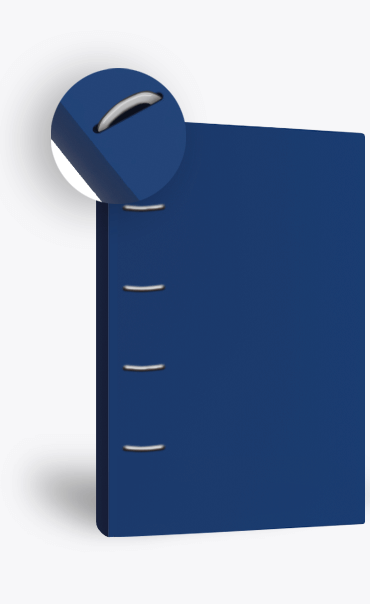
Other bindings
Velo binding
| Velo binding uses a thin plastic strip with pins inserted through pre-punched holes along the spine. A second strip is attached on the back, and the pins are melted or secured. | ||
| Type of binding | Pages are punched along the edge. A plastic strip with pins is placed on the front and a matching strip on the back. The pins are heat-sealed. | |
Pros
|
Cons
|
|
Use
|
Similar bindings
|
|
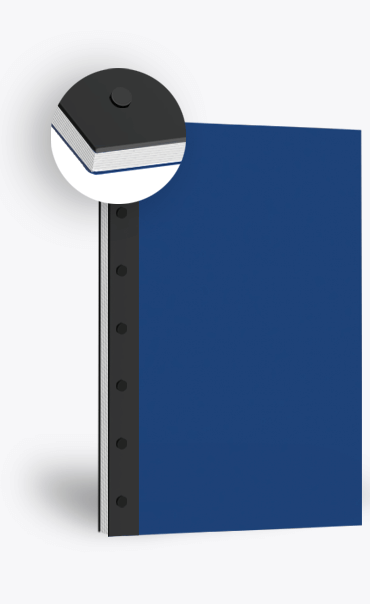
Anthropodermic bibliopegy
| Anthropodermic bibliopegy is the practice of binding books with human skin. Historically, it was used for anatomical texts and personal keepsakes during the 17th to 19th centuries, often for macabre or symbolic purposes. | ||
| Type of binding | Book block is sewn or glued and encased in a cover made from human skin. The material is often tanned and treated like leather to preserve it. | |
Pros
|
Cons
|
|
Use
|
Similar bindings
|
|
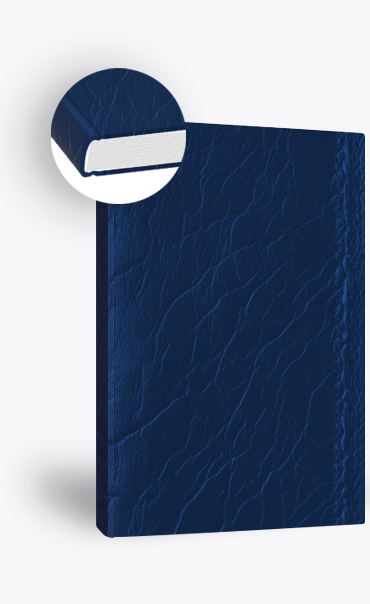
Cloth binding
| Cloth binding is a durable and traditional bookbinding method where the cover is wrapped in cloth material, such as cotton, linen, or buckram. It provides a sturdy and textured finish, often used for high-quality books. | ||
| Type of binding | Book block is sewn or glued and attached to a rigid cover (case). The cover is wrapped in cloth material. | |
Pros
|
Cons
|
|
Use
|
Similar bindings
|
|
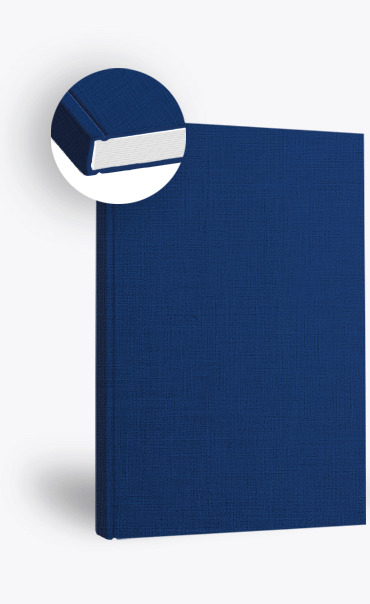
Long-stitch bookbinding
| Long-stitch bookbinding is a traditional hand-sewn method where the book block is sewn directly through a soft cover using long, visible stitches along the spine. This creates a decorative and flexible finish. | ||
| Type of binding | Folded signatures are sewn through slots or holes cut into the spine of the cover. The stitches remain exposed, and no glue is used. | |
Pros
|
Cons
|
|
Use
|
Similar bindings
|
|
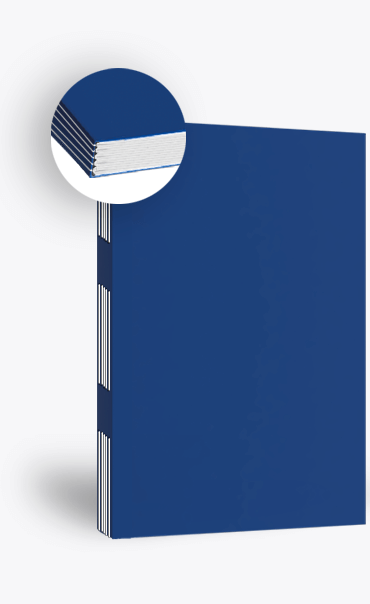
Traditional Chinese bookbinding
| Traditional Chinese bookbinding is an ancient method where folded pages are stacked and sewn together using thread along the spine. This stitching remains visible, creating a clean and elegant appearance. | ||
| Type of binding | Folded sheets of paper are stacked and sewn along the spine with thread in a series of evenly spaced holes. | |
Pros
|
Cons
|
|
Use
|
Similar bindings
|
|
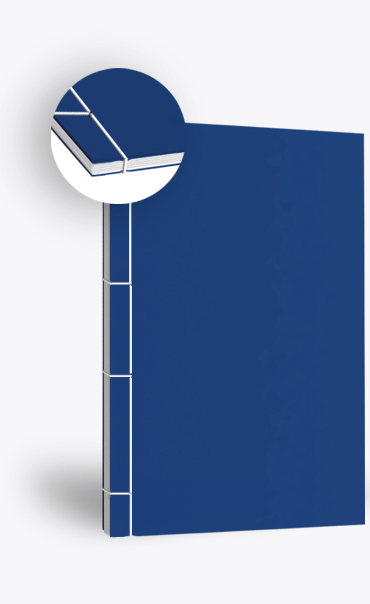
Vellum binding
| Vellum binding is a traditional bookbinding method where the cover is made from vellum, a high-quality parchment prepared from calf, goat, or sheep skin. It is known for its historical significance. | ||
| Type of binding | Book block is sewn or glued and attached to a cover made of vellum. Vellum may remain plain or be decorated. | |
Pros
|
Cons
|
|
Use
|
Similar bindings
|
|
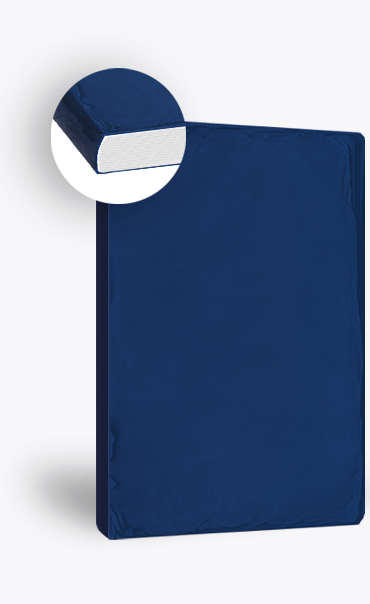
Limp binding
| Limp binding is a bookbinding method where the cover, typically made of leather or vellum, is attached to the book block without stiff boards. This results in a lightweight and pliable book. | ||
| Type of binding | Book block is sewn and attached to a flexible cover material. The cover has no rigid boards. | |
Pros
|
Cons
|
|
Use
|
Similar bindings
|
|
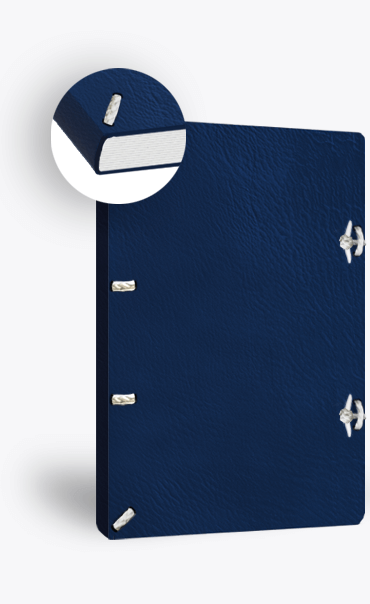
Limp leather binding
| Limp leather binding is a bookbinding method where the book block is covered in soft leather without the use of rigid boards. This creates a lightweight and durable book cover with a classic appearance. | ||
| Type of binding | Book block is sewn together, and the soft leather cover is attached directly to it. The leather cover conforms to the book's shape. | |
Pros
|
Cons
|
|
Use
|
Similar bindings
|
|
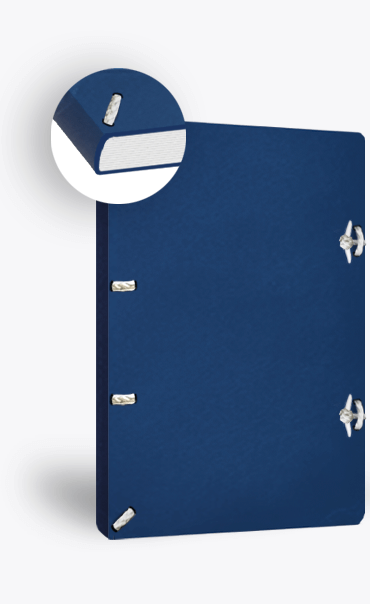
Embroidered binding
| Embroidered binding is a decorative method where the book cover, typically made of fabric, is embellished with embroidery. Designs are hand-stitched or machine-stitched, adding a unique, personalized look. | ||
| Type of binding | Book block is sewn or glued to a fabric cover that is pre-decorated with embroidery. Techniques include hand-stitching patterns, motifs, or lettering. | |
Pros
|
Cons
|
|
Use
|
Similar bindings
|
|
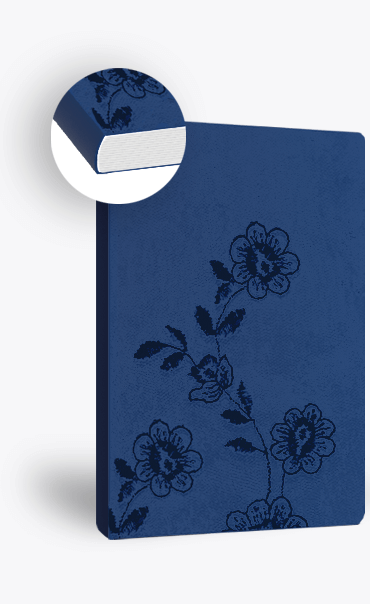
Coptic binding
| Coptic bindings consist of multiple or single sections of parchment, papyrus, or paper sewn through their folds and linked with chain stitches across the spine. They don't use cords or thongs. | ||
| Type of binding | Book block is sewn together using a chain stitch. The covers are attached to the first and last sections without a traditional spine. | |
Pros
|
Cons
|
|
Use
|
Similar bindings
|
|
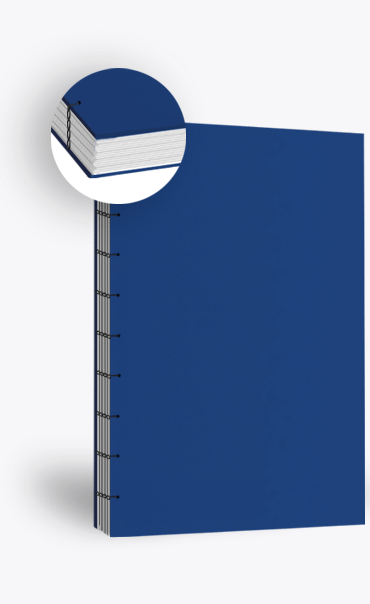
Accordion binding
| Accordion binding is a method where a single long sheet of paper is folded back and forth in a zigzag pattern, creating a series of connected pages that can be expanded/collapsed like an accordion. | ||
| Type of binding | Paper is folded into evenly spaced sections, with no stitching or glue needed. Covers can be attached to the first and last panels. | |
Pros
|
Cons
|
|
Use
|
Similar bindings
|
|

French fold binding
| French folding binding is a method where each sheet of paper is folded in half, creating a double-leaf page with the folded edge at the fore edge. The folded sheets are bound together, often sewn or glued. | ||
| Type of binding | Sheets are folded once and bound together, sewn through the spine or glued. This creates a layered, double-leaf effect. | |
Pros
|
Cons
|
|
Use
|
Similar bindings
|
|
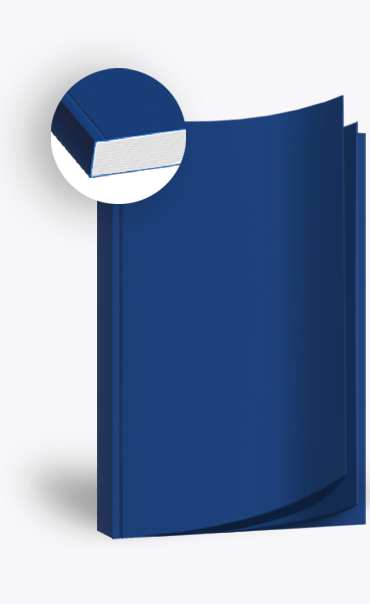
Screw binding
| Screw binding is a method where pages are held together using metal or plastic screws threaded through pre-punched holes along the spine. It creates a sturdy and adjustable binding. | ||
| Type of binding | Pages are punched with evenly spaced holes, and binding screws are inserted through the holes and secured with caps. | |
Pros
|
Cons
|
|
Use
|
Similar bindings
|
|
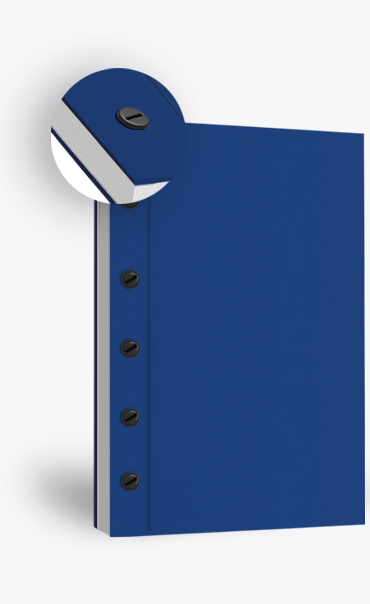
Screw post binding
| Screw post binding is a method where pages are secured using metal or plastic posts inserted through pre-punched holes and fastened with screw caps. It allows for easy assembly of the content. | ||
| Type of binding | Pages are hole-punched along the binding edge, and screw posts are inserted through the holes. These are tightened with caps. | |
Pros
|
Cons
|
|
Use
|
Similar bindings
|
|
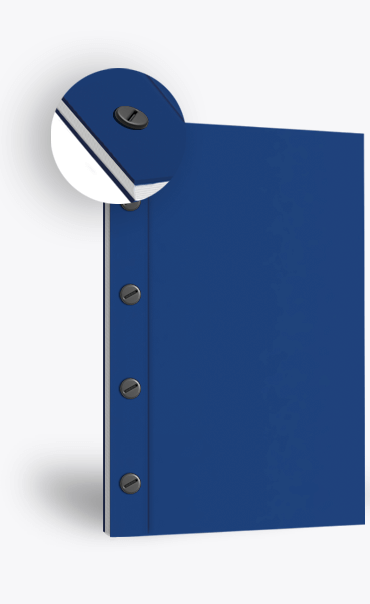
Chicago screw binding
| Chicago screw binding is a method where pages are secured together using metal or plastic screws. It allows for easy customization of content, ideal for professional and flexible projects. | ||
| Type of binding | Pre-punched pages are aligned, and screws are inserted through the holes. The screws are then tightened with a cap. | |
Pros
|
Cons
|
|
Use
|
Similar bindings
|
|
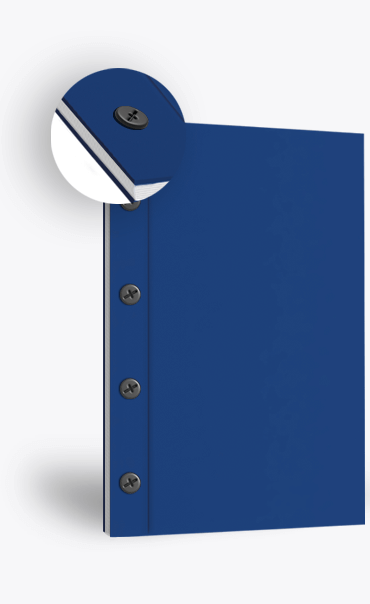
Post binding
| Post binding is a method where pages are secured using binding posts (metal or plastic) inserted through pre-punched holes. The posts are fastened with screw caps, allowing for a sturdy and adjustable document binding. | ||
| Type of binding | Pages are hole-punched along the spine, and posts are threaded through. The posts are tightened with caps to hold the pages together securely. | |
Pros
|
Cons
|
|
Use
|
Similar bindings
|
|
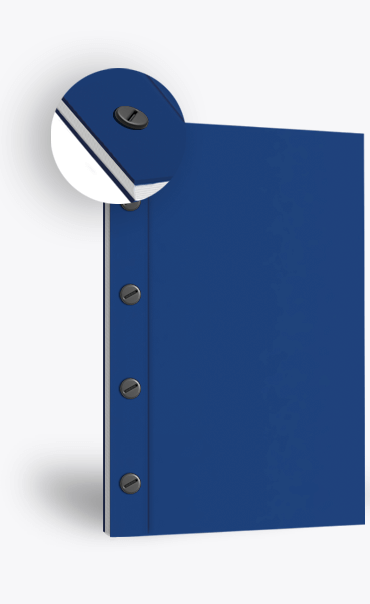
Japanese stab binding
| Japanese stab binding is a traditional hand-sewn binding technique where folded or single sheets of paper are stitched together using thread along the spine edge in a decorative pattern, leaving the stitching visible. | ||
| Type of binding | Sheets are stacked, punched with holes near the spine edge, and sewn together using decorative patterns. No glue or folding of pages is required. | |
Pros
|
Cons
|
|
Use
|
Similar bindings
|
|
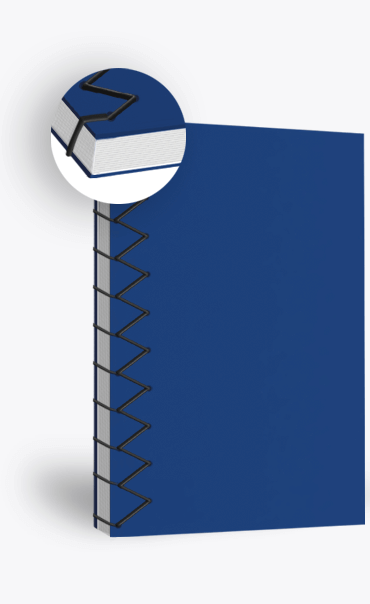
Exposed spine binding
| Exposed spine binding is a binding method where the spine is intentionally left uncovered, showcasing the stitching or glue that holds the book block together. This creates a minimalist aesthetic while allowing flexibility. | ||
| Type of binding | The stitching/adhesive remains visible, becoming part of the design. Covers are attached to the front and back without connecting across the spine. | |
Pros
|
Cons
|
|
Use
|
Similar bindings
|
|
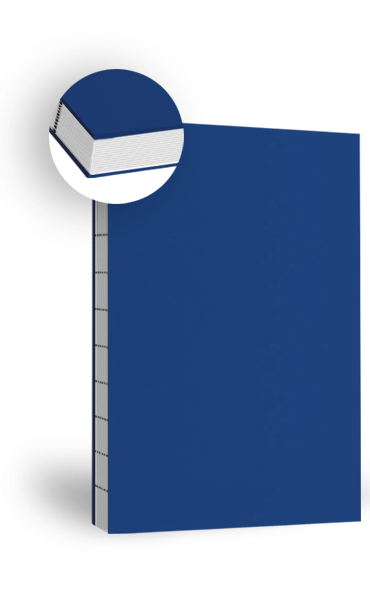
Notepad binding
| Notepad binding is a simple and functional method where the pages of a notepad are glued, stapled, or sewn along one edge, typically at the top or side, allowing for easy tearing of individual sheets. | ||
| Type of binding | Pages are stacked and secured using either glue, staples, or stitching along the edge. The binding holds the pages together. | |
Pros
|
Cons
|
|
Use
|
Similar bindings
|
|
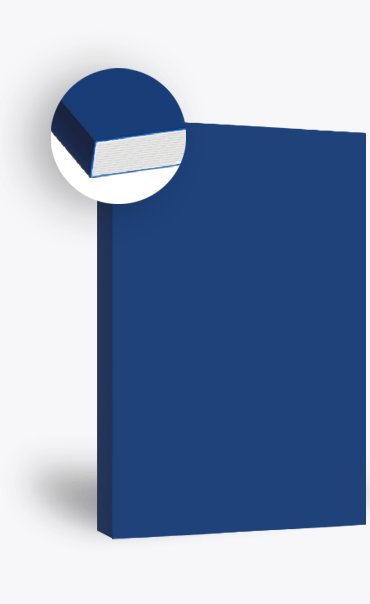
Pad binding
| Pad binding is a simple and cost-effective method where pages are glued together along one edge, typically the top or side, allowing for easy removal of individual sheets. | ||
| Type of binding | Loose sheets are stacked and glued along the binding edge using strong adhesive. A backing board is often added for rigidity. | |
Pros
|
Cons
|
|
Use
|
Similar bindings
|
|
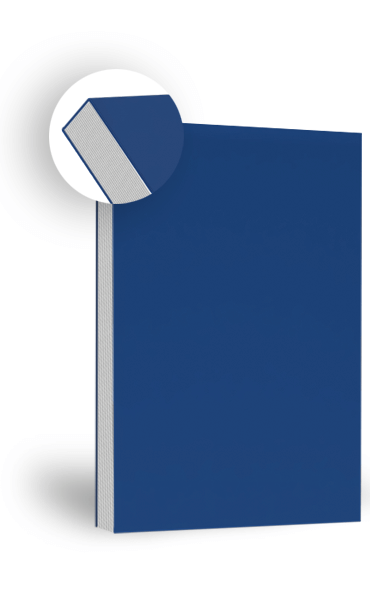
Lay-flat binding
| Lay-flat binding is a method that allows the book to open completely flat without damaging the spine. This is achieved with special adhesives or stitching techniques that provide flexibility. | ||
| Type of binding | Book block is either glued with flexible adhesives or sewn in a way that separates the spine from the pages, preventing strain on the spine. | |
Pros
|
Cons
|
|
Use
|
Similar bindings
|
|
